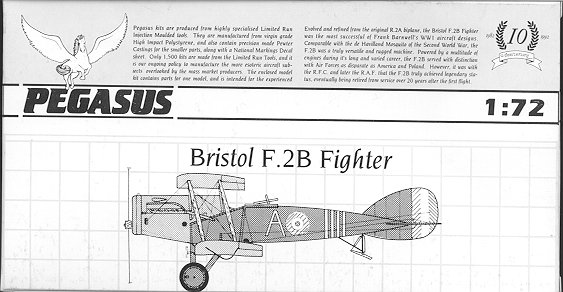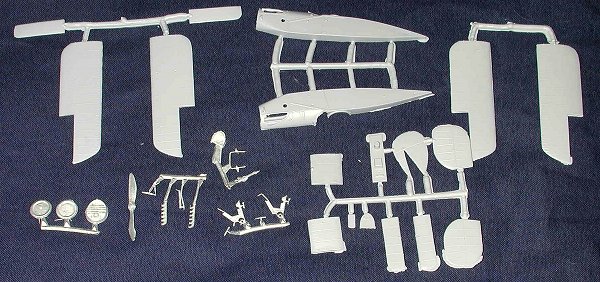
|
KIT: |
Pegasus 1/72 Bristol F.2B "Brisfit" |
|
KIT # |
4012 |
|
PRICE: |
$29.98 ($25.96 from Squadron) |
|
DECALS: |
One aircraft: 139 Sq RFC |
|
REVIEWER: |
|
|
NOTES: |
Short Run with metal parts |

|
HISTORY |
The Bristol F.2 was designed by Captain Frank Barnwell of the British & Colonial Aeroplane Company. His aim had been to replace the aging BE.2s that were such easy targets for the German fighters.
Barnwell's early design in March 1916 would have been powered by the 120 hp Beardmore. However, at that time Rolls-Royce brought out the much more powerful Falcon I, which could develop 190 hp. Barnwell recognized that this extra power would transform his design from a reconnaissance aircraft to a two-seater fighter.
The Bristol F.2A made its first flight on 9 September 1916, and by March 1917 the first aircraft was delivered to front-line squadrons. The F.2A was quickly followed by the F.2B, which had a slightly larger tailplane, some structural changes to the wings and improved cockpit vision. The F.2B received uprated versions of the Rolls-Royce Falcon. The Falcon II developed 220 hp, but this was quickly followed by the 275 hp Falcon Ill. With this engine, the RFC pilots found they had a magnificent fighting tool.
With the Falcon Ill engine the RFC found they had not only all the power they wanted but a sweet running engine with unsurpassed reliability. At last, it mattered little whether the observer had one gun or, as was usually the case, two. In addition he could carry as many as eight massive 97-round drums of ammunition, which often had to be changed while the aircraft was flung through the freezing skies. Hanging a dozen 20-lb bombs under the lower wing was also no problem, though most of the Bristol's countless missions were various kinds of 'offensive patrol' without seeking surface targets.
By the end of the war, 14 squadrons were flying the Bristol Fighter, which was popularly known as the 'Brisfit' or 'Biff'. Unlike most other Allied aircraft, it had stayed in production after the end of the war. It is a tribute to Barnwell's design that Bristol F.2s were still flying in service with the Royal Air Force up until 1932.
My knowledge of the Brisfit is minimal at best. The above was gleaned from several web sites.
|
THE KIT |

Pegasus has been doing short run kits for a while. In fact, the box even touts its 10th anniversary of 1992. Obviously they had a lot of extra boxes as they are now celebrating 20 years of short run models. In that time, not too much has changed in their kits. They have found a niche and something that works well for them so they have stuck with it.
Opening the box, you'll find several sprues of thick, softish plastic. There is some flash as can be expected, but nothing major. A problem with using thick plastic is that it is prone to sink areas and a very few of these were found. None too bad so filling and clean up will be easy. The plastic parts themselves are well detailed and are of the raised panel line variety. One has to remember that this is a WWI aircraft. This not only means few panels, but most of them were stitched together and not riveted so engraving would be very much out of character.
The plastic bits include the fuselage, wings, fin, horizontal stabilizers, instrument panel, and cockpit floor. A nice touch is that the ailerons are separate from the wings. With the softness of the plastic, it should be no problem to similarly remove the elevators so that the plane can be displayed with the controls slightly askew. The rest of the components are in metal. These metal parts are very well formed, though the usual amount of clean-up will be needed to remove some of the metal 'sprue gates'.
The box states that it is for experienced modelers and that is because you'll have to do some fabrication. You see, there are several lengths of metal wire included along with diagrams in the instructions as to how long to cut them. These the builder will have to fashion into various bits such as the main axle, control stick, wing skids and bits for the tail skid. There are also several different diameters of strut material. These will be used for part of the landing gear and the wing struts. Again, there are guides on the instructions to help. It seems as if there is plenty of material so don't fret mistakes.
 The instructions are, well, basic.
They consist of an exploded diagram of the kit and some painting information on
one side, and generic construction hints on the other. Pegasus also prints these
on a very busy background that frankly, makes it rather difficult to read. I
think that returning to a plain white background would be a lot better.
The instructions are, well, basic.
They consist of an exploded diagram of the kit and some painting information on
one side, and generic construction hints on the other. Pegasus also prints these
on a very busy background that frankly, makes it rather difficult to read. I
think that returning to a plain white background would be a lot better.
There is a very nice decal sheet for a single aircraft from 139 Sq RFC. On the side of the box is a mini history and some helpful painting information. The back of the box shows a four view to assist in painting and decal placement.
|
CONCLUSIONS |
This is the second F.2B to be done in 1/72. The previous kit is a very old Airfix model that is undoubtedly not at accurate as this one is. It is also much less expensive. This kit is for those who are comfortable with the extra work that will need to be done and should produce a superior finished product.
You can find this kit and many others at
 . Thanks for your
support.
. Thanks for your
support.
If you would like your product reviewed fairly and fairly quickly where it will be seen by well over 150,000 visitors a month, please contact me or see other details in the Note to Contributors.